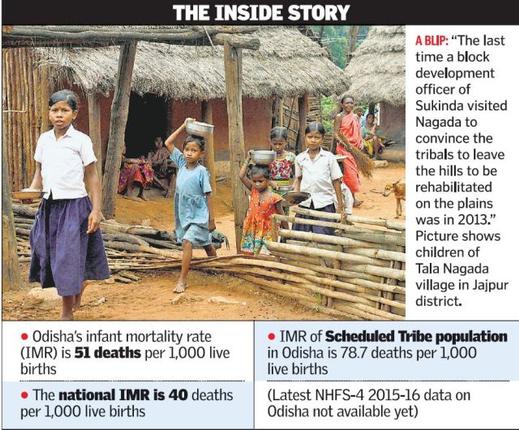
A history of neglect
-
Odisha has 62 tribes, the highest number among all States and Union Territories in the country, accounting for 22.85 per cent of the total population as per 2011 census.
-
As many as 13 of these tribes have been identified as Particularly Vulnerable Tribal Groups (PVTGs), living in over 500 habitations of the State but mostly in hamlets inside the forested hills across Odisha.
-
The Juang tribe is one of the PVTGs that belong to the Munda ethnic group and live in Keonjhar, Dhenkanal, Angul and Jajpur districts of Odisha and speak the Juang language, which is accepted as a branch of the greater Austroasiatic language family. Those who come down the hills at regular intervals have picked up Odia.
-
It was to bring the Juangs into the mainstream that the Juang Development Agency (JDA) was established in 1975, with its headquarters in Gonasika Hills in Keonjhar district.
-
Even after four decades have elapsed, the agency has not been able to go beyond the Juangs of Keonjhar.
-
The tragedy at Nagada involving the Juang tribe exposes the government’s apathy towards the PVTGs, but this is not for the first time that malnutrition-related deaths have stalked the tribal children.
-
In 2013, several malnourished Paudi Bhuyan tribal children had allegedly died of diseases caused by acute malnutrition in Lahunipara block of Sundargarh district, over 200 km away from Nagada.
Following media reports about acute malnutrition among Paudi Bhuyan children, the State Women and Child Development Department, in consultation with Scheduled Caste and Scheduled Tribes, health and family welfare, rural development and panchayati raj departments, had prepared a guideline for a convergent health and nutrition plan to address the health and nutritional needs of PVTGs in the State.
Last-mile connectivity issues
-
The Nagada deaths raise questions on the efficiency of plans and schemes launched for the welfare of tribals living in inaccessible areas, including the Nutrition Operational Plan that was drawn up in 2009 to accelerate the pace of underweight reduction in Odisha. About 38 per cent of children in the State are stunted, its prevalence highest at about 46 per cent among tribal children.
-
As nutrition needs of the PVTGs remain unaddressed with the failure to ensure road connectivity to their habitations, the government has also failed to bring them under the ambit of the National Food Security Act. Though ration cards had been issued to a majority of these tribals, Antyodaya Anna Yojana (AAY) cards elude many of them despite a standing order of the Supreme Court that “ that all households belonging to six priority groups, one of them PVTGs, would be entitled to AAY cards”.
-
It is not geographical isolation alone, but exclusion of the tribals from many government programmes that has made hundreds of children suffer from acute undernourishment in Odisha. A coordinated approach by different government departments is the need of the hour to bring all PVTGs living atop forested hills in the State under the welfare programmes.
Classic IAS Academy :
The Classic IAS Academy is considered the Best Civil Services Coaching in Delhi. The Classic IAS Academy is aimed to develop amongst its students a competitive attitude along with sound academic base with quality teaching. It is also one of the top most IAS academies in India.

Leave a Reply
You must be logged in to post a comment.